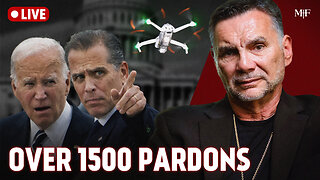Premium Only Content

Episode 2780: Hollywood's Portrayal of Sacred Figures: Part 2: Mary
Introduction Prayer:
Heavenly Father,
We gather in Your holy presence, seeking wisdom and clarity as we discuss the depiction of Your divine truth in media today. Grant us the grace to discern what honors You and leads souls closer to Your Sacred Heart. May the Holy Spirit guide our words and reflections, so we remain steadfast in our love for Your Son, Jesus Christ, and the teachings of His Church.
Through the intercession of the Blessed Virgin Mary, the pure and perfect Mother of God, help us to reflect her humility and faithfulness as we examine how her life and the lives of the saints are portrayed. St. Joseph, foster father of Jesus and protector of the Holy Family, pray for us as we seek to uphold the dignity of Christ and His Church in our discussion. We ask this in the name of Jesus Christ, our Lord. Amen.
As part two of this series Hollywood's Portrayal of Sacred Figures what is the concern?
When the Catholic Church does not insist on portraying the traditional Catholic perspective of the lives of Mary and Jesus in films, it risks permitting or enabling theological misrepresentations or errors that could lead to confusion among the faithful. The potential theological issues or errors in this context may include:
1. Indifferentism
Indifferentism is the idea that all beliefs are equally valid or that the Church does not need to uphold its unique teachings in public or cultural expressions. When films fail to accurately depict key Catholic doctrines and the Church does not take a stance, it may seem as though the Church is indifferent to the truth it proclaims, which can lead to scandal.
2. Heresy of Modernism
Modernism, condemned by Pope St. Pius X in Pascendi Dominici Gregis, involves diluting or reinterpreting traditional Catholic doctrines to align with modern sensibilities or ideas. Allowing films to reduce the supernatural nature of events or the unique roles of Mary and Jesus for artistic or ecumenical reasons could fall into this error.
3. Scandal
The Catechism of the Catholic Church defines scandal as “an attitude or behavior which leads another to do evil” (CCC 2284). By allowing a film to misrepresent or oversimplify Catholic teachings, the Church may unintentionally give the impression that these teachings are unimportant, potentially leading viewers away from the fullness of truth.
4. Relativism
Relativism, where truth is seen as subjective and open to interpretation, undermines the objective truth of Catholic doctrine. Films that portray Mary or Jesus in ways that contradict Church teaching can propagate relativistic ideas if the Church does not provide clear guidance or critique.
5. Cultural Accommodation
Over-accommodating cultural trends at the expense of doctrinal integrity risks distorting the Gospel message. The Church's failure to demand fidelity to tradition in such portrayals might be perceived as prioritizing popular appeal over theological accuracy.
Addressing These Issues:
The Church has mechanisms to evaluate media representations of faith through organizations like the Pontifical Council for Culture and episcopal conferences. A lack of action or oversight might result in confusion among Catholics and weaken the Church's evangelizing mission. Engaging with filmmakers to promote accurate portrayals and educating the faithful on Church teachings are critical steps in addressing potential errors or heresies.
The 2024 Netflix film Mary was directed by D.J. Caruso and produced by Mary Aloe. The film was created with significant input from both Catholic and Protestant perspectives. It was rooted in Catholic theology, reflecting doctrines such as the Immaculate Conception and the Perpetual Virginity of Mary, while also seeking to appeal to a broader Christian audience, including Protestant viewers. The script and production aimed to highlight Mary's humanity and faith in a way that fosters unity and dialogue among different Christian denominations.
D.J. Caruso, the director, has not explicitly stated his personal religious affiliation, though his previous works have often dealt with themes of morality and faith. Producer Mary Aloe described the project as one of faith, hope, and love, aiming to transcend denominational divides and promote a shared understanding of Mary’s significance.
The film draws on biblical and apocryphal texts to provide a theologically rich and accessible portrayal of Mary, making it a landmark effort to bring Marian theology to a global audience through mainstream media like Netflix. This dual effort by Catholic and Protestant collaborators reflects the film's intent to engage with Christian unity while maintaining theological depth
The 2024 Netflix film Mary takes significant artistic liberties with the depiction of the Virgin Mary, blending some biblical and apocryphal elements while introducing secularized and Protestant perspectives. While it portrays moments like Joachim’s and Anne’s longing for a child, the film diverges from traditional Catholic teachings in several critical areas:
• Mary's Characterization
• Christ's Centrality
• Historical and Theological Accuracy
• Tone and Intent
Mary's Characterization: The film depicts Mary in ways inconsistent with Catholic doctrine, such as downplaying her perpetual virginity and portraying her with a more secular attitude. For example, Mary expresses dissatisfaction with her consecrated life and shows reluctance in embracing her role as Mother of God. These choices align more with modern sensibilities than with traditional Catholic reverence.
Downplaying Mary's Perpetual Virginity
The film avoids a clear affirmation of Mary’s perpetual virginity, which is a cornerstone of Catholic teaching. Instead, Mary is depicted as saying she "can't have a child," a statement that could be misinterpreted as a physical inability rather than a vow of virginity. This omission reduces the theological significance of her virginity as a sign of her total consecration to God and her unique role in salvation history
The Direct - North Texas Catholic
Secularized Attitude Toward Her Role
In the movie, Mary expresses dissatisfaction with her consecrated life, questioning, “How can I do anything important if I’m stuck in here?” Such sentiments suggest that she views her life in the Temple as limiting, rather than a privileged preparation for her divine mission. This characterization contrasts sharply with Catholic tradition, which portrays Mary as joyfully obedient and fully accepting of God’s will.
North Texas Catholic - Reluctance to Embrace Her Role
The Annunciation scene is particularly troubling in its depiction of Mary’s response. Instead of enthusiastically consenting to God's plan, the film has her quietly state, “let it be me,” which emphasizes herself rather than her submission to God’s will. This diminishes the profound theological significance of her fiat (“Let it be done to me according to your word” - Luke 1:38), which marks her as the perfect model of faith and humility
The Direct - North Texas Catholic
Depicting Mary in a Relatable but Diminished Light
The film’s attempt to make Mary relatable results in a portrayal that emphasizes her humanity at the expense of her divine role. For example, Mary tells little lies to temple sages and likens her betrothal to being “sold off” as a “prized steed.” These choices align more closely with a Protestant perspective that sees Mary as an ordinary woman chosen by God, rather than the sinless Mother of God uniquely graced for her mission
North Texas Catholic - Implications for Catholic Viewers
By portraying Mary with reluctance, dissatisfaction, and secular reasoning, the film undermines her role as the archetype of perfect obedience to God’s will. This mischaracterization could lead viewers to misunderstand her unique sanctity and diminish her role in the story of salvation.
These deviations highlight the film's departure from a Catholic perspective, making it a potentially misleading portrayal for those seeking an authentic representation of Our Lady.
Christ's Centrality: The movie marginalizes Jesus, particularly in His infancy. His presence is not treated with the profound reverence central to Catholic theology, which emphasizes His divinity from conception. This diminishes the spiritual depth expected in a depiction of the Holy Family.
In Catholic tradition, every moment of Christ’s life, from His conception to His resurrection, carries profound theological weight, particularly the Incarnation, which represents God becoming man for the redemption of humanity. Here's a deeper analysis of the film's shortcomings in this regard:
1. Jesus as a Marginalized Presence
The narrative of Mary treats Jesus as an ancillary figure, emphasizing Mary’s personal struggles and journey rather than her role in relation to Christ. This approach shifts the focus away from Christ as the source and purpose of Mary’s mission and instead places undue emphasis on her humanity and personal agency.
For instance, the portrayal of Mary’s reaction to the Annunciation and her preparation for Christ’s birth minimizes her awareness of Jesus’ divine nature and mission, presenting Him more as her child than as the Savior.
2. Lack of Emphasis on His Divinity
Catholic theology teaches that Jesus was fully God and fully man from the moment of His conception (John 1:14). The Annunciation, the Visitation, and the Nativity are deeply Christocentric events, emphasizing Jesus as the Word made flesh. However, in the film, these events are portrayed with a focus on naturalistic and human aspects, downplaying their divine significance.
For example, the Nativity scene lacks the awe and reverence traditionally associated with the moment, such as the adoration by the shepherds and Magi, which underscore Christ's kingship and divine mission (Luke 2:8-20; Matthew 2:1-12).
3. Missed Opportunities to Highlight the Incarnation
The Incarnation is the central mystery of Christianity, yet the film portrays the birth of Jesus in an understated manner. There is little recognition of the cosmic significance of the event, which Catholic tradition celebrates as the moment when God entered human history to redeem the world.
The film focuses on Mary and Joseph’s human struggles during the birth, rather than framing these challenges as part of the divine plan. This diminishes the spiritual depth of the Holy Family's role in salvation history.
4. Misrepresentation of the Holy Family
Catholic teaching holds that the Holy Family's every action was oriented toward the mission of Jesus Christ. By not centering Jesus in the story, the film risks portraying Mary and Joseph as ordinary individuals facing worldly challenges, rather than as chosen instruments of God's plan.
For example, Joseph’s role as the guardian of the Redeemer is not given its proper theological weight, which detracts from the unity and Christocentric purpose of the Holy Family.
5. Theological Implications for Viewers
By marginalizing Jesus, the film misrepresents Mary’s identity as Theotokos (God-bearer) and her unique mission to bring Christ into the world for the salvation of souls.
This approach risks leading viewers to a flawed understanding of the relationship between Mary and Jesus, reducing her role to that of a mother with personal struggles, rather than emphasizing her divine calling as the Mother of God.
Traditional Catholic View
In Catholic devotion and theology, Mary is never considered apart from Christ. Her life is entirely oriented toward Him, and her greatness lies in her humility, obedience, and participation in His salvific mission. Any depiction of Mary that does not place Christ at the center fails to align with Catholic doctrine and risks misrepresenting the profound spiritual realities of the Holy Family.
While the film may have artistic merit, its failure to maintain Christ’s centrality undermines its alignment with Catholic theology. Viewers should approach Mary critically, supplementing it with authentic Catholic resources to deepen their understanding of the Virgin Mary and her indispensable role in Christ’s mission. For an accurate portrayal of these themes, Catholics may prefer films like The Nativity Story or devotional reflections on the Rosary, which emphasize Christ’s divinity and centrality.
Historical and Theological Accuracy: Elements such as Satan’s physical temptations of Mary and Joseph's omission from Gabriel's annunciation contradict Scripture and tradition. The movie also presents key moments like the Annunciation in a manner that shifts the focus away from God’s will.
1. Satan’s Physical Temptations of Mary
The film introduces an episode where Satan tempts Mary in a physical and direct manner. This is not grounded in Scripture or Catholic tradition, which do not mention such an event. Catholic teaching focuses on Mary as the "New Eve," whose Immaculate Conception and complete obedience to God make her immune to Satan's influence in the manner of physical temptation (Genesis 3:15, Luke 1:28).
Furthermore, the Church portrays Mary as constantly protected by God’s grace. Any suggestion that she entertained or struggled against Satan's temptations diminishes her role as the sinless Mother of God.
2. Joseph's Omission from the Annunciation
The film overlooks St. Joseph’s role in the divine plan by excluding his encounter with the Angel Gabriel, as described in Matthew 1:18-25. In Scripture, the angel explicitly reassures Joseph about Mary's divine pregnancy, affirming his essential role as the earthly father of Jesus and protector of the Holy Family.
By neglecting Joseph’s annunciation, the film diminishes his obedience and the spiritual significance of his actions. Catholic tradition holds St. Joseph in high esteem as the "just man" (Matthew 1:19) who fully embraced his role in God’s plan.
3. Shifting Focus Away from God’s Will in Key Moments
In the Annunciation scene, the film alters Mary’s response to the Angel Gabriel (Luke 1:38). Traditionally, her fiat ("Let it be done to me according to your word") is celebrated as a profound act of humility and trust in God’s will.
However, the movie’s portrayal of Mary’s response as subdued and uncertain shifts the emphasis away from her complete surrender to God’s plan. This misrepresentation undermines the theological depth of the Annunciation as a moment of divine-human cooperation in the history of salvation.
4. Inaccurate Representation of Historical Context
The film takes liberties with the cultural and religious practices of Mary and Joseph’s time. For example, the suggestion that Mary felt “trapped” in the Temple or questioned her betrothal to Joseph is not reflective of Jewish practices or the traditional understanding of their lives.
Mary’s upbringing in the Temple is traditionally understood as a time of preparation for her role in God’s plan, rather than a restrictive or limiting experience. Similarly, her betrothal to Joseph was not merely a contractual obligation but a divinely orchestrated union.
5. Theological Consequences of These Deviations
Undermining God’s Providence: By introducing unbiblical elements like Satan’s physical temptations and portraying key figures like Mary and Joseph as uncertain or reluctant participants, the film diminishes the narrative of God’s providence guiding the events of salvation history.
Modern Psychological Interpretations: The movie projects contemporary attitudes and psychological struggles onto figures like Mary and Joseph, which risks distorting their unique roles in salvation history and presenting them as fallible in ways contrary to Catholic doctrine.
Catholic Perspective on These Issues
The Church emphasizes fidelity to Scripture and tradition in presenting the lives of Mary and Joseph. Deviations like those in Mary compromise theological truths and can mislead viewers unfamiliar with Catholic teaching.
Films that respect biblical accounts (e.g., The Nativity Story) avoid these pitfalls by adhering to historical and scriptural accuracy while still portraying the humanity of Mary and Joseph in harmony with their divinely appointed roles.
By blending modern reinterpretations with unbiblical elements, Mary risks misrepresenting key aspects of the Holy Family’s lives and diminishing the spiritual depth of their story. For Catholic audiences, these inaccuracies should be critically considered alongside authentic Church teachings.
Tone and Intent: The film attempts to make Mary more relatable, which results in presenting her as an ordinary young woman rather than the unique, sinless Mother of God. This portrayal aligns with Protestant viewpoints, which typically emphasize Mary's humanity over her divine role.
1. Depiction of Mary’s Humanity
In an effort to make Mary seem relatable, the film portrays her primarily as an ordinary young woman grappling with doubts and personal struggles. While Catholic theology acknowledges Mary’s humanity, it simultaneously upholds her unique role as the sinless Mother of God (Theotokos) and her unwavering faith in God’s plan.
The Catholic view of Mary is inseparable from her Immaculate Conception, which preserves her from sin and enables her to respond fully and freely to God’s will (Catechism of the Catholic Church 491-492). The film, however, downplays these aspects, potentially aligning her characterization more closely with Protestant perspectives, which often emphasize her humanity over her divine role.
2. Contrast with Catholic Teachings
Protestant Perspective: Many Protestant traditions view Mary as a holy but ordinary woman chosen by God, rejecting doctrines like her perpetual virginity and Immaculate Conception. This focus on her humanity over her divine mission can lead to depictions that minimize her spiritual perfection and exceptional role in salvation history.
Catholic Perspective: Mary is not merely relatable but is exalted as the perfect model of faith and obedience. Her fiat at the Annunciation (Luke 1:38) reflects complete surrender to God’s will, not hesitancy or self-doubt. Any portrayal of Mary that diminishes her singular grace or holiness diverges from Catholic tradition.
3. Impact on Audience Perception
The film’s tone may resonate with modern audiences seeking a connection to biblical figures through shared human experiences. However, this approach risks distorting the theological truths about Mary’s life and mission. By focusing on her struggles and uncertainties, the film may inadvertently lead viewers to see Mary as fallible in ways inconsistent with Catholic doctrine.
This tone also aligns with broader cultural trends that seek to humanize religious figures by stripping away their sacred and transcendent qualities, which can diminish their spiritual significance.
4. Examples from the Film
Reluctance at the Annunciation: Instead of fully embracing God’s will with confidence, Mary is portrayed as hesitant and uncertain. This contrasts with Catholic tradition, which celebrates her fiat as the pinnacle of faith and humility.
Dissatisfaction with Her Role: The film suggests that Mary struggles to accept her vocation as Mother of God, a departure from Catholic teachings, which emphasize her joyful acceptance of this divine mission. This characterization might appeal to Protestant or secular viewpoints but misrepresents her unique relationship with God.
5. Cultural and Ecumenical Implications
By prioritizing relatability, the film adopts a tone that may unintentionally align more with Protestant theology, which rejects or minimizes Marian dogmas like the Assumption and Immaculate Conception. This ecumenical approach, while well-intentioned, can undermine Catholic teachings by presenting a watered-down version of Mary’s identity.
Catholic viewers familiar with Marian devotion, such as the Rosary or titles like "Queen of Heaven," may find this portrayal lacking in reverence and theological depth.
Catholic Evaluation of Tone and Intent
The Catholic Church venerates Mary as the Mother of God, whose life was uniquely sanctified by divine grace. While exploring her humanity can be valuable, this must not come at the expense of her divine role. The film's attempt to present Mary as "just like us" risks eroding the profound mysteries surrounding her life and the Incarnation of Christ.
For Catholics, a faithful representation of Mary is one that inspires awe and devotion, as seen in traditional portrayals in art, literature, and film (The Song of Bernadette, The Nativity Story). These depictions balance her humanity with her unparalleled role in salvation history, offering a richer and more accurate perspective than the film Mary appears to achieve.
Ultimately, Mary is not aligned with traditional Catholic teachings and could lead to misunderstandings about core tenets of the faith. While some viewers might find value in its artistic elements, its theological and historical inaccuracies make it problematic from a traditional Catholic perspective. Catholics seeking authentic representations of the Virgin Mary should approach the film with caution and consider its shortcomings in portraying Marian theology and Christ's centrality to salvation history.
Conclusion Prayer:
Loving Father,
We thank You for the opportunity to reflect on how Your Word is shared through creative works in our time. Help us to uphold truth with charity, and to encourage others to deepen their understanding of the mysteries of faith. May we always view Christ as the center of our lives and honor the saints who point us toward heaven.
Bless all creators with a reverent spirit, and grant that their work may glorify You and lead others to salvation. Through the intercession of St. Michael the Archangel, defend us in the battle for truth against any error or confusion. As we conclude, may Your peace remain in our hearts and Your Word guide our actions. We ask this in the name of Your Son, Jesus Christ, who lives and reigns forever and ever. Amen.
-
 2:42:35
2:42:35
Jewels Jones Live ®
1 day agoLAWFUL DRONES | A Political Rendezvous - Ep. 102
107K27 -
 4:22:48
4:22:48
Pepkilla
11 hours agoWarzone Ranked Road to 250 ~ HaLLLLPPPPP
85.1K5 -
 2:14:38
2:14:38
SLS - Street League Skateboarding
9 days ago2024 SLS Super Crown São Paulo: Men's Prelims
208K37 -
 1:11:07
1:11:07
PMG
21 hours ago $13.27 earned"Alarming Parallels of Modern America and the Roman Empire | Jeremy Ryan Slate"
74.4K36 -
 46:39
46:39
Stephen Gardner
13 hours ago🔥FINALLY! Trump BLACKMAIL scheme EXPOSED | 'Ukraine will be DESTROYED' worries US Pentagon!
121K187 -
![Devin Nunes - Truth Social Gets An Upgrade, We Will Celebrate The Destruction Of The [DS] With Wine](https://1a-1791.com/video/s8/1/0/G/j/J/0GjJv.0kob-small-Devin-Nunes-Truth-Social-Ge.jpg) 50:15
50:15
X22 Report
15 hours agoDevin Nunes - Truth Social Gets An Upgrade, We Will Celebrate The Destruction Of The [DS] With Wine
248K219 -
 1:40:54
1:40:54
Michael Franzese
1 day agoBiden's not done destroying America & what happened in New Jersey?
104K131 -
 1:20:47
1:20:47
SLS - Street League Skateboarding
9 days ago2024 SLS Super Crown São Paulo: Women's Prelims
158K7 -
 15:14
15:14
DeVory Darkins
1 day ago $30.53 earnedDemocrats PANIC After Fetterman Meets with Pete Hegseth
115K154 -
 1:49:05
1:49:05
Tactical Advisor
14 hours agoQuitting my Job & Giveaway Winner! | Vault Room Live Stream 010
84.6K19